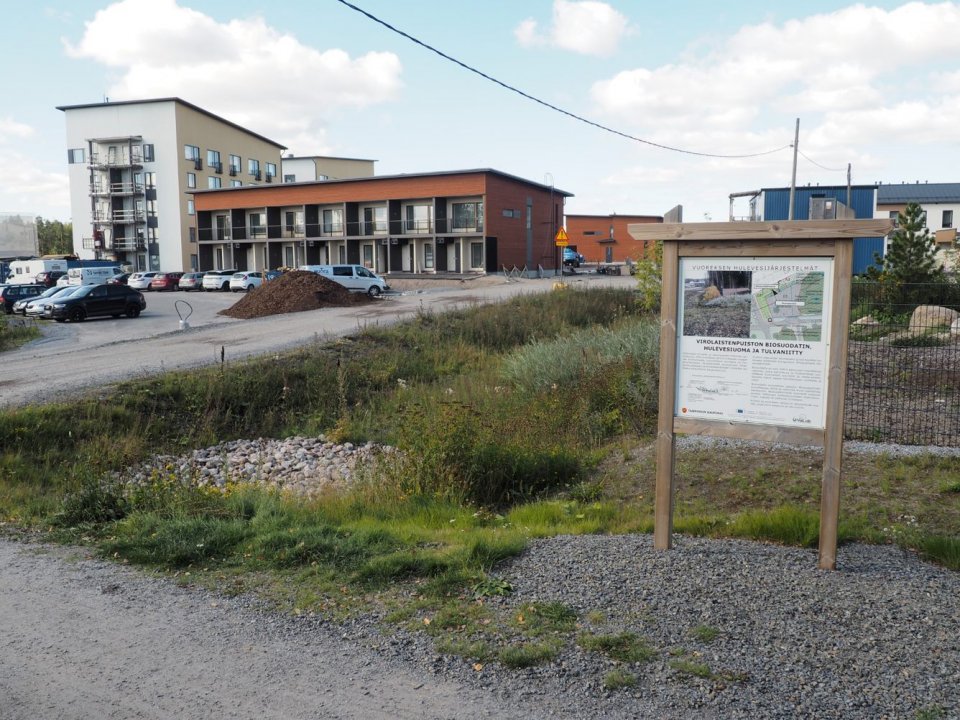
The biofilter’s catchment area is approximately 3.5 ha. The catchment area is a new development area mostly consisting of small detached apartment houses and streets. The biofilter also receives some surface runoff from the nearby dog park. The streets of the catchment area are drained with a conventional separated pipe drainage system. The biofilter area is just under 300 m2. The filter’s vegetation consists of a sown mixture of domestic wild alluvial meadow plants. The biofilter has a total of 600 mm of filtrating layers. Underneath the filtration layers, is a perforated underdrain pipe. The biofilter has an overflow through an elevated manhole attached to a stormwater pipe. The underdrain is also connected to this system.
A biofilter was implemented in Vuores to treat urban runoff and runoff from a nearby dog park. The biofilter uses sand as filtering media and the vegetation planted on top of the filter includes plants that tolerate changing moisture conditions. The biofilter is equipped with the information sign explaining the nature-based solution and its functions.
Flooding indicators included those related to surface runoff, time to flood peak and flood peak height (or, water depth), and they were evaluated with the help of modelling. Biofilter in Vuores demonstrated 55% reduction of surface runoff for a 1-year return period, 22% for a 10-year and 7% for a 100-year return periods when compared to no NbS situation. According to the simulations, the biofilter NbS decreased runoff coefficients in all the simulated events, but the effect diminished with increasing precipitation intensities. Biofilter in Vuores demonstrated 56% reduction of water depth, 19% for a 10-year return period and 17.5% for a 100-year return periods when compared to no NbS situation. From the simulation results, NbS have a positive effect in flood peak height reduction. The biofilter performs best in lower intensity rainfall events, with effectiveness decreasing as return periods increase. It greatly delayed flood peak time in both lower and higher precipitation events (+94% and +70% for a 1- and 100-year return periods) yet had no effect at intermediate precipitation levels.
In the survey regarding the Vuores stormwater management system, the respondents rated highly such aspects as easiness of reach, aesthetics and feeling of connectedness with nature. Aspects related to increased physical activity, extending time spent outdoors or making a longer route received score from 3.6 to 4. In total 93% of Vuores residents perceived the stormwater management system as improving their living conditions.
- Flood peak reduction
- Increase infiltration / Water storage
- Reduce run-off
- Increase Biodiversity
- Changing image of the urban environment
- Improve water quality
- Increase awareness of NBS solution & their effectiveness and co benefits
Results from Tampere and other studies show that, in many cases, sand-based biofiltration is a cost-efficient solution for storm water purification. As the performance of the biofilter is not solely dependent on the vegetation, the filters also function in the Nordic climate. A sand-based biofilter is effective in phosphorus, suspended solids and pathogen removal, but does not retain nitrogen. If the removal of nitrogen is important for watercourses downstream of the runoff site, biochar or expanded clay aggregate can instead be used as filtering material. Additionally, it should be possible to enhance the removal of nitrogen with the suitable selection of vegetation. With a large drainage basin and therefore large amounts of water, the capacity of the biofilter needs to be sufficient or, alternatively, multiple solutions need to be used.
The decentralised, hybrid (grey, blue and green infrastructure) stormwater management system of Vuores performs well for retention and purification of urban runoff. However, interpretation of monitoring data was challenging at times due to the complexity of the system. There is an uncertainty related to biofilters' life cycle as it is dependent on at least the quality and quantity of water channelled into the filtration area and the filtering materials used.
- Biofilter
